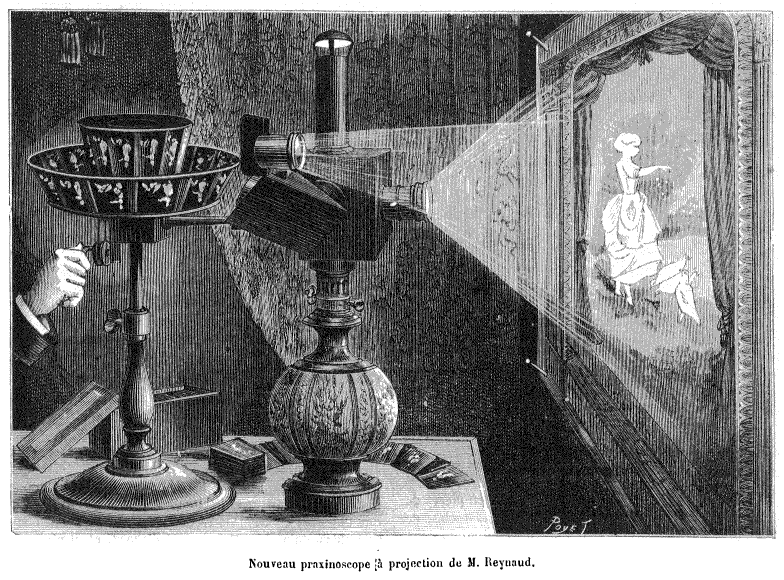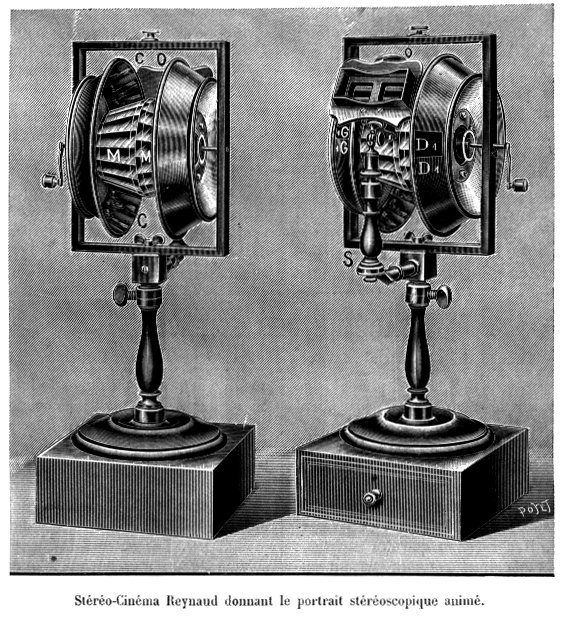Émile Reynaud on:
[Wikipedia]
[Google]
[Amazon]
Charles-Émile Reynaud (8 December 1844 – 9 January 1918) was a French inventor, responsible for the praxinoscope (an animation device patented in 1877 that improved on the 


short
File:Emile_Reynaud_Bande_praxinoscope_3.ogg, ''La Rosace Magique''
File:Emile_Reynaud_Bande_praxinoscope_2.ogg, ''Le Trapèze''
File:Emile_Reynaud_Bande_praxinoscope_4.ogg, ''Le singe musicien''
File:Emile_Reynaud_Bande_praxinoscope_1.ogg, ''Le fumeur''
 * The praxinoscope, 1876
* The praxinoscope-jouet (toy praxinoscope), 1877
* The praxinoscope-théâtre, 1879
* The projecting praxinoscope, 1880
* Image bands with central
* The praxinoscope, 1876
* The praxinoscope-jouet (toy praxinoscope), 1877
* The praxinoscope-théâtre, 1879
* The projecting praxinoscope, 1880
* Image bands with central
Kinodinamico
Biography
from the
zoetrope
A zoetrope is one of several pre-film animation devices that produce the illusion of motion by displaying a sequence of drawings or photographs showing progressive phases of that motion. It was basically a cylindrical variation of the phénak ...
) and was responsible for the first projected animated films. His ''Pantomimes Lumineuses''
premiered on 28 October 1892 in Paris. His Théâtre Optique
The Théâtre Optique (Optical Theatre) is an animated moving picture system invented by Émile Reynaud and patented in 1888. From 28 October 1892 to March 1900 Reynaud gave over 12,800 shows to a total of over 500,000 visitors at the Musée Grév ...
film system, patented in 1888, is also notable as the first known instance of film perforations
Film perforations, also known as perfs and sprocket holes, are the holes placed in the film stock during manufacturing and used for transporting (by sprockets and claws) and steadying (by pin registration) the film. Films may have different types ...
being used. The performances predated Auguste and Louis Lumière
The Lumière brothers (, ; ), Auguste Marie Louis Nicolas Lumière (19 October 1862 – 10 April 1954) and Louis Jean Lumière (5 October 1864 – 6 June 1948), were French manufacturers of photography equipment, best known for their ''Ciném ...
's first paid public screening of the cinematographe on 26 December 1895, often seen as the birth of cinema.

Biography
Charles-Émile Reynaud was born on 8 December 1844 in Montreuil-sous-Bois (now a suburb of Paris). His father Benoît-Claude-Brutus Reynaud was an engineer and medal engraver originally fromLe Puy-en-Velay
Le Puy-en-Velay (, literally ''Le Puy in Velay''; oc, Lo Puèi de Velai ) is the prefecture of the Haute-Loire department in the Auvergne-Rhône-Alpes region of south-central France.
Located near the river Loire, the city is famous for its c ...
and his mother Marie-Caroline Bellanger had been a school teacher, but
stayed at home to raise and educate Émile from his birth. Marie-Caroline was trained in watercolor painting
Watercolor (American English) or watercolour (British English; see spelling differences), also ''aquarelle'' (; from Italian diminutive of Latin ''aqua'' "water"), is a painting method”Watercolor may be as old as art itself, going back to ...
by Pierre-Joseph Redouté
Pierre-Joseph Redouté (, 10 July 1759 – 19 June 1840), was a painter and botanist from Belgium, known for his watercolours of roses, lilies and other flowers at the Château de Malmaison, many of which were published as large, coloured ...
and taught her son drawing and painting techniques. Brutus gave him little tasks in his workshop and by the age of 13 Émile was able to build small steam engines. In 1858 he became an apprentice at a Paris company where he repaired, assembled and developed optical and physics instruments. He then learned industrial design at another company, before working as an operator for photographer Antoine Samuel Adam-Salomon
Antoine Samuel Adam-Salomon (9 January 1818 – 28 April 1881) was a French sculptor and photographer.
Early career
Antoine Samuel Adam-Salomon was born to a French Jewish family on 9 January 1818 in La Ferté-sous-Jouarre, Seine-et-Marne, ...
. By 1862 he started his own career as a photographer in Paris. He became an assistant to the famous Abbé Moigno in 1864. Moigno gave lecture-screenings with the magic lantern
The magic lantern, also known by its Latin name , is an early type of image projector that used pictures—paintings, prints, or photographs—on transparent plates (usually made of glass), one or more lenses, and a light source. Because a si ...
and converted Émile to Catholicism, since his parents had raised him without religion. When his father died in December 1865 Émile moved with his mother to Puy-en-Velay where Brutus' cousin Dr. Claude Auguste Reynaud further educated Émile in Greek, Latin, physics, chemistry, mechanics and natural science.
In December 1873 Émile Reynaud started giving weekly scientific screening-lectures for the students of the industrial schools of Puy-en-Velay, free of charge and open to the general public. He used personally made photographic magic lantern slides in two projectors, sometimes dissolving from one projection to another.
After Reynaud read a series of articles on optical toys published in ''La Nature
''La Nature'' (English: ''Nature'') was a French language magazine aimed at the popularization of science established in 1873 by French scientist and adventurer Gaston Tissandier. The magazine also received an enormous amount of time, effort ...
'' in 1876, he created a prototype praxinoscope out of a discarded cookie box. He applied for a French patent on 30 August 1877 for his then unnamed device (settling on the name ''Praxinoscope'' before the English patent of 13 November 1877) and returned to Paris in December 1877 to manufacture and market his invention.Laurent Mannoni ''Light and Movement'', 1995, pp. 232–233
On 21 October 1879 Émile Reynaud married Marguerite Rémiatte in Paris. They had two sons: Paul (1880) and André (1882).
Similarly to Georges Méliès, Reynaud's late years were tragic after 1910 when, his creations outmoded by the cinematograph, dejected and penniless, he threw the greater part of his irreplaceable work and unique equipment into the Seine. The public had forgotten his "Théâtre Optique" shows, which had been a celebrated attraction at the Musée Grevin between 1892 and 1900. He died in a hospice on the banks of the Seine where he had been cared for since 29 March 1917.


Filmography
The 5 ''Pantomimes Lumineuses'' were painted directly onto a transparent strip of images ofshellac
Shellac () is a resin secreted by the female lac bug on trees in the forests of India and Thailand. It is processed and sold as dry flakes and dissolved in alcohol to make liquid shellac, which is used as a brush-on colorant, food glaze and ...
protected gelatin and manipulated by hand to create an approximately 15 minute show comprising approximately 500 images per title. The three ''Photo-peintures animées'' (animated photo-paintings) were directed with the Photo-Scénographe, a camera inspired by the ''Chronophotographe à bande mobile'' of Étienne-Jules Marey
Étienne-Jules Marey (; 5 March 1830, Beaune, Côte-d'Or – 15 May 1904, Paris) was a French scientist, physiologist and chronophotographer.
His work was significant in the development of cardiology, physical instrumentation, aviation, cinema ...
.
animated
Animation is a method by which still figures are manipulated to appear as moving images. In traditional animation, images are drawn or painted by hand on transparent celluloid sheets to be photographed and exhibited on film. Today, most ani ...
films">
File:Pauvre Pierrot (Emile Reynaud, 1892).webm, Video of ''Pauvre Pierrot
''Pauvre Pierrot'' (or ''Poor Pete'') is a French short animated film directed by Charles-Émile Reynaud in 1891 and released in 1892. It consists of 500 individually painted images and lasts about 15 minutes originally.
It is one of the first ...
'', the first preserved animated cartoon, 1891
File:1894 - Autour D'une Cabine.webm, Autour D'une Cabine, from 1894, one of the first animated films
File:Autour d'une cabine.png, ''Autour d'une cabine''
Praxinoscope strips (1877–1879)
Series 1
* ''L'Aquarium'' * ''Le Jongleur'' * ''L'Équilibriste'' * ''Le Repas des Poulets'' * ''Les Bulles de Savon'' * ''Le Rotisseur'' * ''La Danse sur la Corde'' * ''Les Chiens Savants'' * ''Le Jeu de Corde'' * ''Zim, Boum, Boum''Series 2
* ''Les Scieurs de Long'' * ''Le Jeu du Volant'' * ''Le Moulin à Eau'' * ''Le Déjeuner de Bébé'' * ''La Rosace Magique'' * ''Les Papillons'' * ''Le Trapèze'' * ''La Nageuse'' * ''Le Singe Musicien'' * ''La Glissade''Series 3
* ''La Charmeuse'' * ''La Balançoire'' * ''L'Hercule'' * ''Les Deux Espiègles'' * ''Le Fumeur'' * ''Le Jeu de grâces'' * ''L'Amazone'' * ''Le Steeple-chase'' * ''Les Petits valseurs'' * ''Les Clowns''Inventions
 * The praxinoscope, 1876
* The praxinoscope-jouet (toy praxinoscope), 1877
* The praxinoscope-théâtre, 1879
* The projecting praxinoscope, 1880
* Image bands with central
* The praxinoscope, 1876
* The praxinoscope-jouet (toy praxinoscope), 1877
* The praxinoscope-théâtre, 1879
* The projecting praxinoscope, 1880
* Image bands with central perforation
A perforation is a small hole in a thin material or web. There is usually more than one perforation in an organized fashion, where all of the holes collectively are called a ''perforation''. The process of creating perforations is called perfor ...
.
* The Théâtre Optique
The Théâtre Optique (Optical Theatre) is an animated moving picture system invented by Émile Reynaud and patented in 1888. From 28 October 1892 to March 1900 Reynaud gave over 12,800 shows to a total of over 500,000 visitors at the Musée Grév ...
, 1888
* The stéréo-cinéma (animations in 3D), 1907
Books and references
* Dominique Auzel, ''Émile Reynaud et l'image s'anima'' biographie d'Émile Reynaud **éditions du May (1992), (photos en couleurs) **And at Dreamland éditeur (2000), (photos en noir et blanc)References
External links
*Kinodinamico
Biography
from the
Cinémathèque française
The Cinémathèque Française (), founded in 1936, is a French non-profit film organization that holds one of the largest archives of film documents and film-related objects in the world. Based in Paris's 12th arrondissement, the archive offers ...
{{DEFAULTSORT:Reynaud, Charles-Emile
1844 births
1918 deaths
Cinema pioneers
19th-century French inventors
French animators
French animated film directors
People from Montreuil, Seine-Saint-Denis
Articles containing video clips